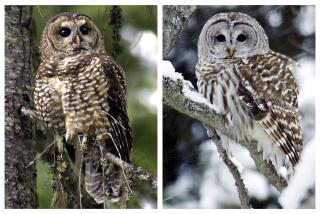One ranch, 26 wolves killed: Fight over endangered predators divides ranchers and conservationists

- Share via
LAURIER, Wash. — When Washington ranchers find that gray wolves have attacked their cattle, they can call the state wildlife agency, which has killed 31 of the protected predators since 2012 under a program intended to save vulnerable livestock.
Many ranches have routinely used state-contracted range riders to ward off wolves, which are listed by Washington as endangered even as they have gradually returned during the last decade after being reintroduced in Idaho.
But not the Diamond M Ranch, which has grazed its cattle on federal land near the U.S.-Canada border in northeast Washington since World War II.
Twenty-six of the 31 eradicated wolves were killed after the Washington Department of Fish & Wildlife deemed that members of their packs had attacked Diamond M livestock.
Environmentalists say the ranch not only fails to take preventive steps to safeguard its herds, but in some cases brings on the bloodshed by leaving cattle near known wolf dens.
Operators of Diamond M deny that’s the case, but are vociferous about their rights. The issue highlights a clash of cultures between rural eastern Washington residents and city dwellers west of the Cascade Range who, they and other cattlemen say, don’t know squat about ranching, wildlife and predators.
“Seattle doesn’t ask us what to do with their homeless, and I don’t think we should have to ask Seattle what to do with our wolves,” said Bill McIrvin, 50, a fourth-generation rancher in the family that owns Diamond M.
Wildlife department officials acknowledge that Diamond M has declined offers of state-funded range riders who could help protect cattle. But the agency is not required to mandate preventive measures before wolves are shot or trapped, they say.
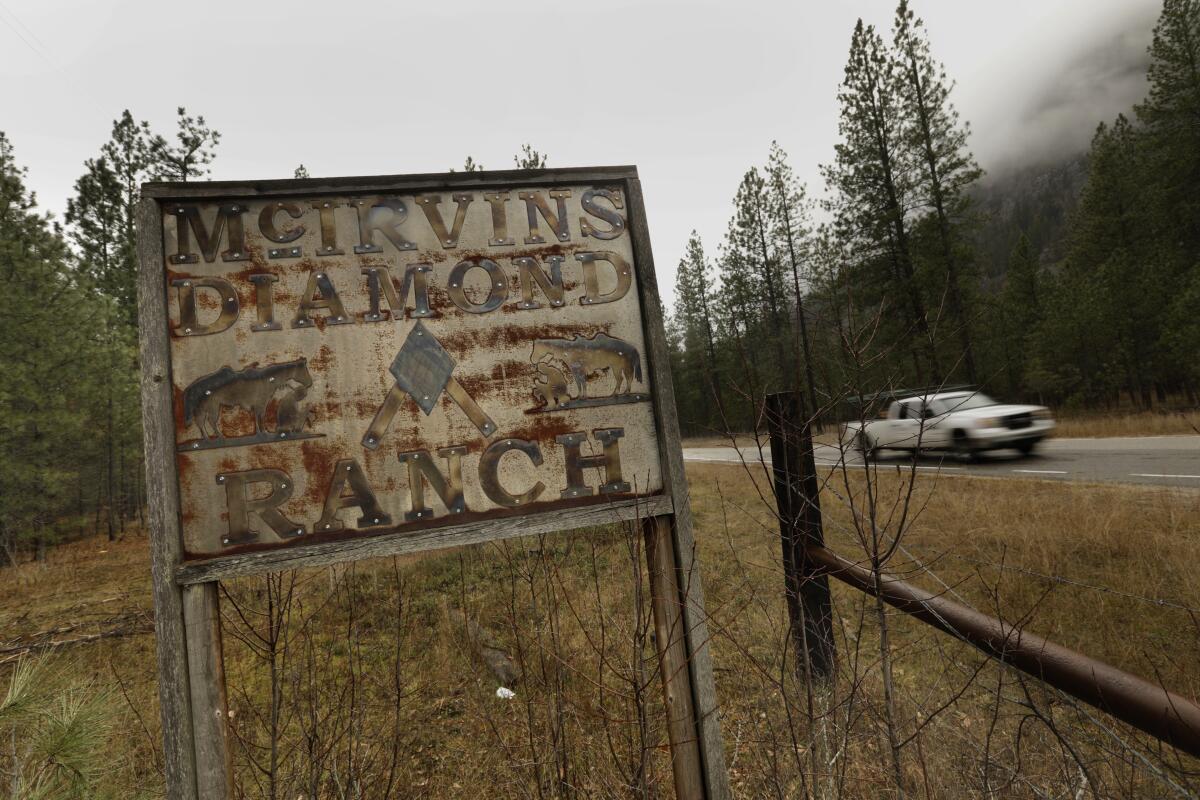
Gov. Jay Inslee has asked that fewer wolves be killed, but his authority is limited to appointing members of a commission that oversees the state agency. When its director replied requesting more funds and promising to develop a new policy in Diamond M’s region by May 1, Inslee said the agency had “not responded with alacrity.”
Passions over wolves are running so high that in August, agency officials cited threats of violence in canceling a statewide series of 14 public meetings to discuss management once recovery is sufficient for Washington to end the species’ endangered status, as Congress did in 2011 in areas including the eastern third of the state. Similar controversy is building in Colorado, where proponents of reintroducing gray wolves submitted signatures Tuesday for an initiative on the state ballot next November, despite opposition from ranchers and state wildlife commissioners.
In Washington, the wolf population had grown to 126 by the end of last year, slowed by the state’s efforts to cull those deemed livestock eaters.
Diamond M itself is a 2,500-acre spread across a mountain pass from the high school Bill McIrvin once attended. Doffing a cowboy hat and muddy boots by the ranch-house door, he sat for an extended interview recently as his wife, Berta, sporting an anti-wolf T-shirt, served coffee.
The stocky cattleman denied goading wolves to attack. Rather, he said, his business has lost $1 million since 2008 from the killings of 75 to 100 cattle a year by wolves — many times the number that the state has officially confirmed — and from declines in weight and pregnancy rates among traumatized livestock.
McIrvin says the problem is clearly the wolves, not the ranch.
“I don’t feel that we have room for wolves in Washington state,” said McIrvin, who said his family would continue to oppose what they see as a broader agenda of wolf advocates and officials. “If it’s allowed to continue, it’s going to drive the ranching industry out of Washington, which is what a lot of people want. We’re just stubborn, and we won’t leave the range.”

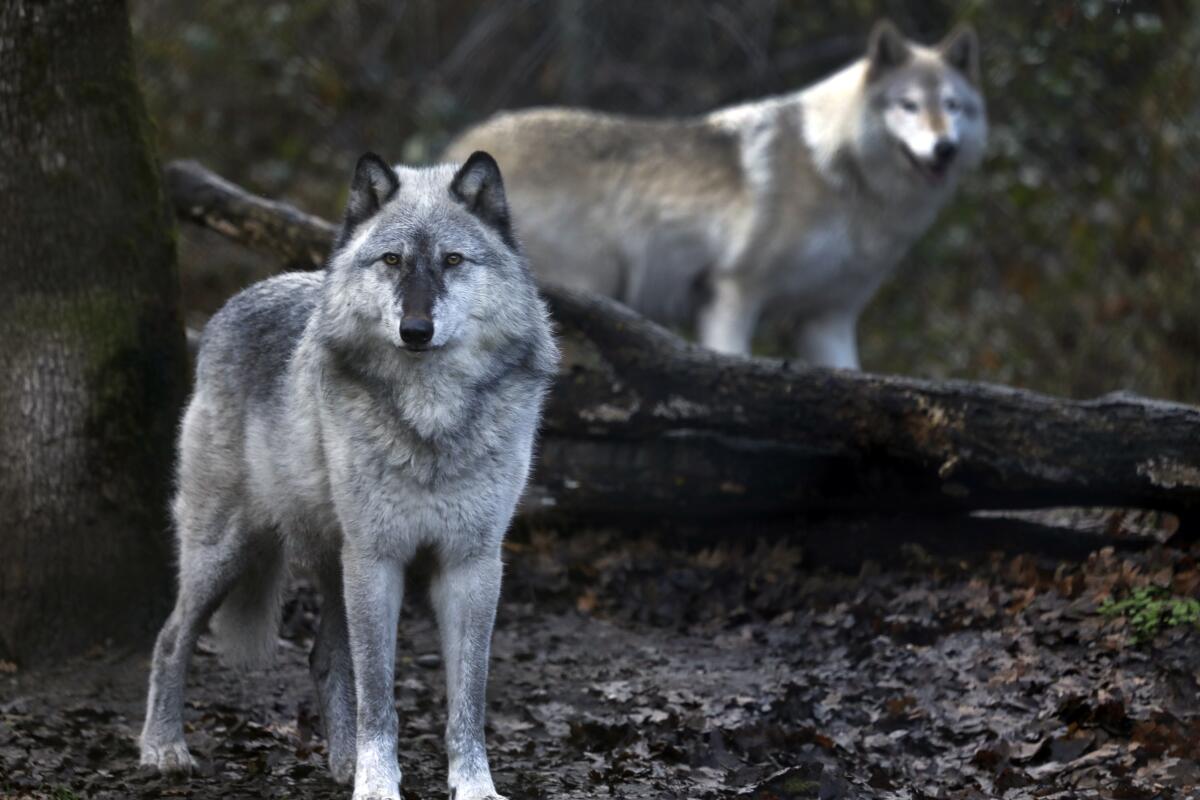
McIrvin views reintroduction of wolves in the West as a plot to end grazing on public land, much as environmentalists used protection of the threatened spotted owl in the 1990s to preserve Northwest forests.
For centuries in the continental United States, government bounties encouraged trapping, shooting and poisoning wolves, which were wiped out across the West by the 1930s. In 1974, gray wolves gained protection under the federal Endangered Species Act, and in 1995 researchers began releasing wolves to Idaho and Yellowstone National Park in Wyoming.
Gradually, wolves spread into Washington, where they will be downgraded to “threatened” status once breeding pairs have established across the state. There are now about 1,500 wolves in Idaho, Montana and Wyoming. Oregon is known to have 137; California, fewer than a dozen.
Wolf advocates see Diamond M as an extreme example of ranchers abusing public land privileges, and the wildlife agency as pandering to cattle producers and hunters by slaughtering animals it’s supposed to protect.
“Year after year, Diamond M reportedly loses cattle to wolves while neighboring producers are able to effectively protect their herds,” said Claire Loebs Davis, an attorney for wolf advocates suing the state wildlife department.
In 2012, all seven members of a wolf family known as the Wedge pack were shot, most from a helicopter, after the Washington wildlife department determined that the group had preyed on Diamond M cattle in grazing allotments in the Colville National Forest.
In 2016, the agency spent $135,000 for a gunner and trapper to kill seven members of the Profanity Peak pack, also blamed for attacking the ranch’s cattle. Over the next three years, the agency killed a dozen more wolves after Diamond M attacks, including the last four members of a pack just hours before animal advocates won a court injunction to save them.
Court fights continue, waged by Washington environmentalists and the Center for Biological Diversity, a national conservation organization. The group obtained state wildlife agency records linking Diamond M to the 26 “lethal removals” — a number that neither the agency nor the ranch disputes, except to note that in one case wolves were also blamed for attacking other cattle.
Davis views the wildlife department as having been “captured” by ranching and hunting interests. The agency counts on revenue from hunting and fishing license fees, which depend significantly on continued access to private ranch land, she noted.
Jay Holzmiller, a southeast Washington hunter and cattle rancher who served a recent six-year term on the state wildlife commission, countered that politicians in the state’s urban areas wield decisive power. “The ranching and hunting community does not have near the influence, nor near the number of attorneys, as ... the environmental side does,” he said.

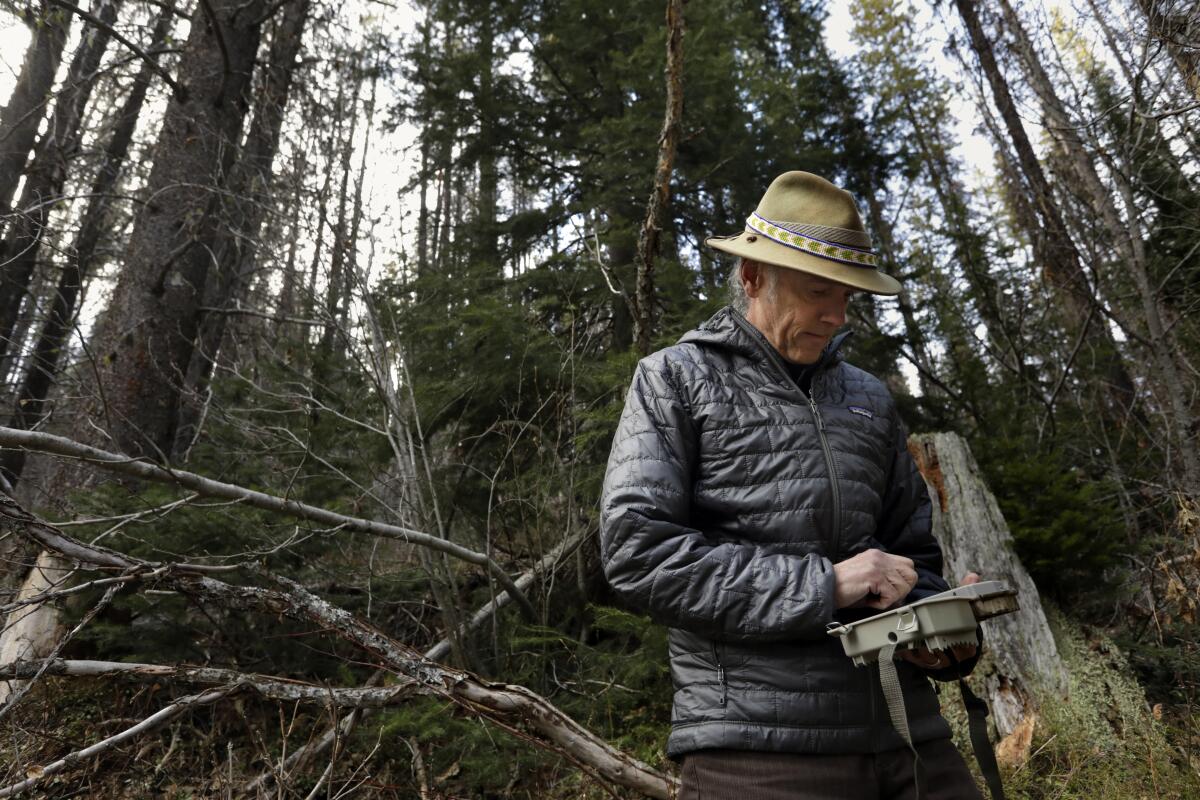
Environmentalists say that restoring the apex predators at the top of the food chain helps revive ecosystems, bringing back songbirds and salmon. They say wolves cull unnaturally large herds of hoofed animals, known as ungulates, allowing vegetation to return, and boosting bird and fish habitat.
“Wolves are what make the wild wild,” said Amaroq Weiss, the Center for Biological Diversity’s senior West Coast wolf advocate, who sees them as crucial to the evolutionary process in which the fittest survive. “If you love ungulates, and how athletic and fast and muscular they are, you have wolves to thank for that,” she said.
Weiss toured a Diamond M federal grazing allotment last month with Tim Coleman, executive director of the local Kettle Range Conservation Group. They drove into thick woodlands in the Colville forest where the ranch has grazed cattle since 1943, much of that time with no threats from wolves.
Last summer, Diamond M paid $4,177 to graze 736 pairs of cows and calves on 80,000 acres, an arrangement Coleman called “cheap babysitting.” He said that one way to prevent cattle from being attacked would be to move them out of deep forests ideal for wolves and onto pastures where they could be readily monitored.
To Travis Fletcher, Colville National Forest district ranger, the solution is to move more quickly to kill wolves that prey on cattle. “By doing it soon enough, you remove the offending wolves that probably killed those livestock,” he said.
The state wildlife agency is allowed to kill wolves after three attacks on livestock in 30 days, or four in 10 months. Officials say they also consider whether shooting or trapping wolves would jeopardize recovery of the species, and whether the cattle owner has used nonlethal measures to prevent attacks.
Donny Martorello, the department’s wolf policy lead, said Diamond M has taken precautions, waiting to turn out cattle for grazing until fawns and elk calves are born in the area, providing wolves with a wild food source.
But he said that range riding is “one of the places we’d like to see improvement,” acknowledging that last summer, Diamond M declined riders offered by the wildlife agency. The agency recommends riders to help keep cattle apart from wolves and to remove dead or ailing cows that attract predators.
Coleman and other environmentalists suing the agency accuse Diamond M of keeping salt blocks near a wolf den, causing cattle to swarm around it. Davis, the wolf advocates’ lawyer, said internal agency documents show that qualified range riders have never patrolled a Diamond M allotment where attacks occurred.
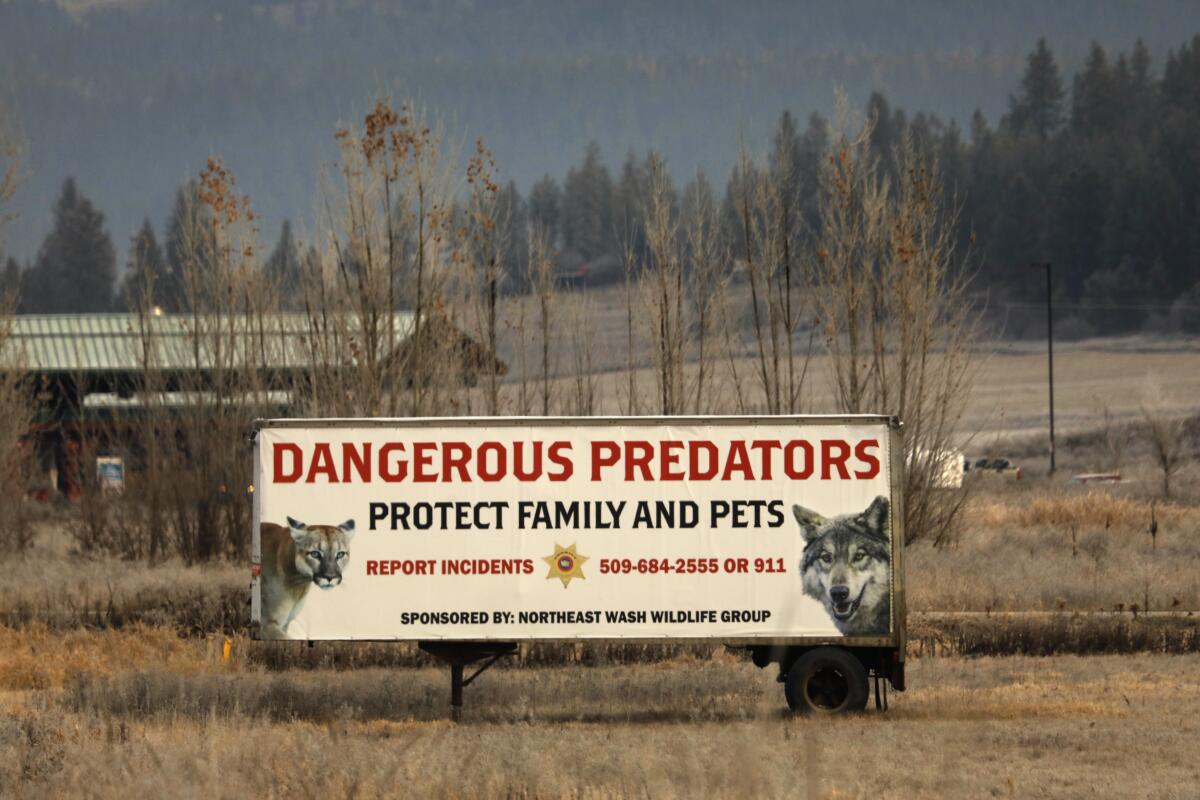
McIrvin, at Diamond M, contends that “government-sponsored range riders ... have never once protected a cow or a calf.”
But range riders counter that they indeed make a difference.
Jan Wright has patrolled on horseback in areas near Diamond M‘s federal grazing allotments, safeguarding cattle belonging to five other ranches. Her territory has included parts of the Colville forest, where about 10,000 cattle grazed last summer from 34 livestock producers including Diamond M.
Contracted by the wildlife agency, Wright works to deter wolves by hanging up cloth strips and carrying a gun that shoots whistle flares. She removes dead and injured cattle that might attract carnivores. And she outfits cattle with cowbells.
“When they wear bell collars, it sounds like the cavalry are coming,” Wright said. “The ranches that I’ve been riding for in the last few years have not had wolf kills.”
More to Read
Sign up for Essential California
The most important California stories and recommendations in your inbox every morning.
You may occasionally receive promotional content from the Los Angeles Times.


